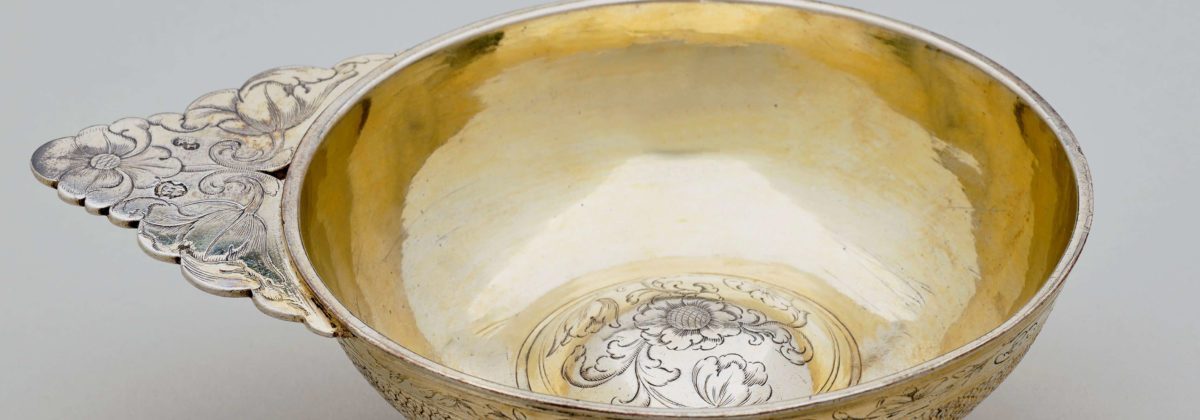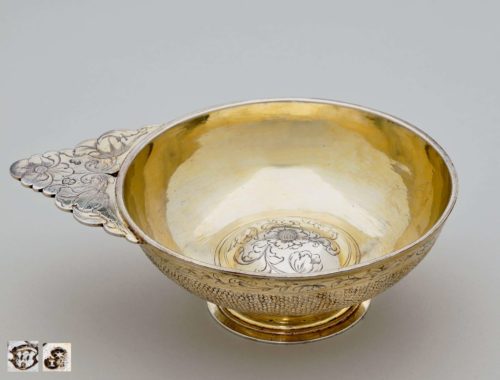Object number #386
Hamburg ca. 1670
Johann Brockmer
City’s hallmark: the coat of arms of Hamburg as a mark
Maker’s mark: “IB” with a star above for Johann Brockmer (s. Schliemann, no. 240, p. 191).
Length with handle: 16 cm (6, ¼ in.); height: 5,1 cm; Dm: 12 cm; weight: 270 gr. (8 oz. 13 dwt.)
Publ./Fig.: Schliemann, vol. 3, fig. 375, p. 159.
Detailed Description
Drinking Bowl (Tcharka), Silver Gilt
The round, solid-walled drinking bowl stands on a low, slightly vaulted round foot. It has a beautifully preserved, matted outer wall. Above and below the exterior walls, decorated with friezes of engraved leaf and flower tendrils. In the inner bottom of the bowl a round vaulted centre engraved, with fine roses and tulips. The horizontal, flat handle bears the engraving of three flowers, which simultaneously define its outline. The marks are ligated on the handle.
Tcharka and Vodka
The tcharka, also known as a vodka cup or mug, appeared in the 16th and mainly in the 17th century in the form of a small tchara (vessel for brandy). Later it was used as a small cup with a vertical handle or as a tumbler without a handle. In the course of the 18th century, various shapes were developed that followed the trends of this time period. The surface is often smooth and decorated with engravings, similar to the present high-quality Hamburg drinking bowl. Since the beginning of the 19thcentury, glasses have been used for vodka. In the 20th century Tcharki made of silver or gold was used again.
The word “vodka” comes from the Russian “woda”, which means “water” or “little water”. The history of this drink begins in the 15thcentury, when the Russians tried to produce alcohol based on cereals. They called this “water from bread”. When the drink was first produced, vodka was only half as strong as the today’s drink.
Vodka was traditionally produced in Poland and Russia and was consumed in Ukraine, Sweden and Finland next to these two producer-countries. In Northern Germany the drink was also popular and was – as in the rest of Western Europe – drunk and enjoyed until the end of the 19thcentury by aristocrats as a rare Eastern European specialty.
Maker
Johann Brockmer learnt by his father Berendt Johann during 1643-48 and became a citizen in 1662. In the same year, he got married and took the function of Peter Ohr I. He had many apprentees in his workshop, among them his son Berend Johan. Several works by Johann Brockmer have survived in public and private collections.
Literatur
Alexander von Solodkoff, Russische Goldschmiedekunst: 17.-19. Jahrhundert. Silber, Email, Niello, Golddosen, Schmuck, München 1981.
Schliemann, Erich (ed.), Die Goldschmiede Hamburgs, vol. I-III, Verlag Schliemann & Cie: Hamburg, 1985.



